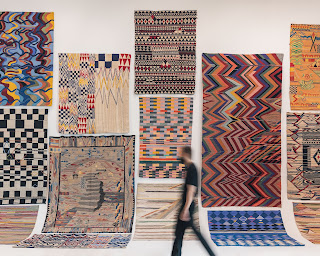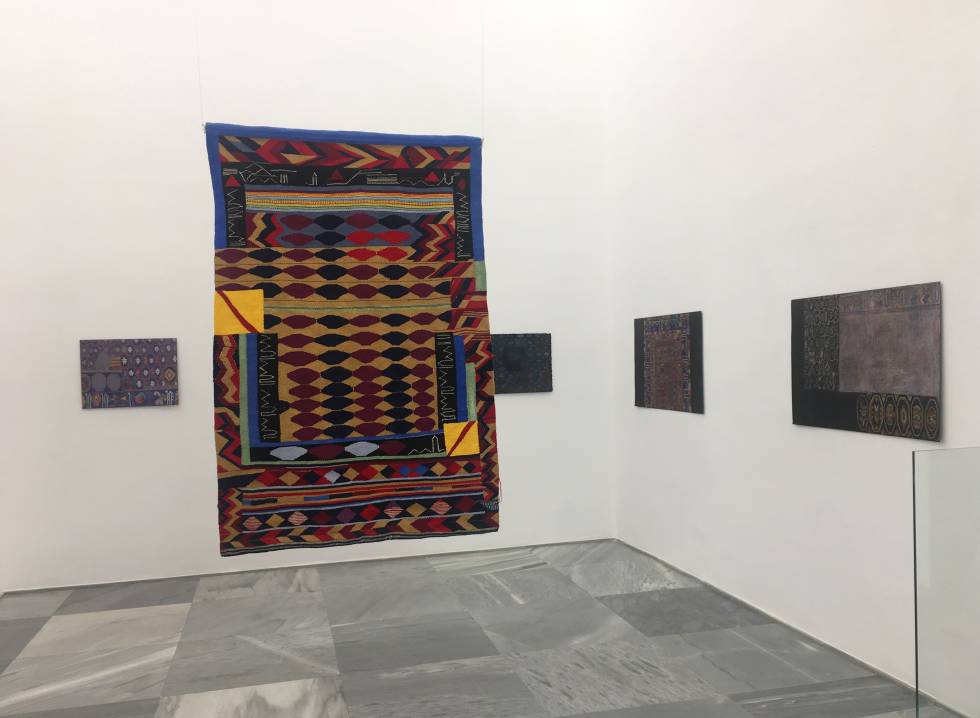INVITASJONER
A
cura di Pedro G. Romero
Sacco.
El saco de Roma, las crisis de la representación y los flamencos.
CUADRAS/GALLINERO
Bergen
Assembley
Entre
el 5 de septiembre y el 3 de noviembre de 2019.
Entrada
y salida según horarios de la granja.
Un
evento para gallinas en la granja
Langegården
besøksgård y el espacio del Belgin Bergen en Kode Museum, Bergen, Noruega.
Un
trabajo de
Teresa
Lanceta & Pedro G. Romero
Con
la participación de
Ludovica
Manzetti, Matteo Binci, Cinzia Mariani, María García, Nuria Rodríguez, María
del Mar Villafranca, Tor Steffen Espedal, Kirsten Wandschneider, Erik Krohn
Hansen, Tolga Balci, Anthony Morton, Samuel Mestre, Rafael Marín, Laura Valles,
Ester Pegueroles Castellet, Josefa Aragonés Sancho, Albert Benlloch Enguita,
Pep Benlloch Serrano, Isabel Carballo Municio, Nuria Enguita Mayo, Carmen
Lanceta Aragonés y Félix Molada Mora.
Fotografía
de gallinas. Anthony Morton para Teresa Lanceta & Pedro G. Romero, 2019.
Dentro
del proyecto “political parties/Asamblea General” curado por María García &
Pedro G. Romero para la Bergen Assembley 2019, ACTUALLY, THE DEAD ARE NOT
DEAD, un proyecto comisariado por Hans D. Christ and Iris Dressler, con
Murat Deha Boduroglu, María García, Hiwa K, Katia Krupennikova, Viktor Neumann,
Paul B. Preciado, Pedro G. Romero, Simos Sheikh and Emma Wolukau-Wanambwa.
Bergen
Assembley/Kunstvereim Stuttgart.
Real
Academia de España en Roma.
AC/E,
Acción Cultural Española.
***
El
punto de partida se encuentra en el relato del historiador bizantino Procopio
de Cesarea, que en su De bello vandalico dice así: “Uno de sus eunucos
se acercó al emperador Honorio y le dijo que Roma había perecido. Visiblemente
impresionado el emperador gritó: Y sin embargo, ha comido de mi mano hace
unos instantes!. Porque él tenía una gallina muy grande, su favorita,
llamada Roma. El eunuco comprendió la confusión y le dijo que era la ciudad de
Roma la que había perecido a manos de Alarico. El emperador, con un suspiro de
alivio, respondió rápidamente: Pero yo, mi buen amigo, pensé que era mi
gallina Roma la que había perecido. Tan grande, dicen, fue la locura con la
que estaba poseído este emperador”. Se refiere al famoso saco de Roma del 410,
llevado acabo por los vándalos que dirigía el general Alarico. Edward Gibbon ya
tomó precauciones hacía ésta, literalmente, anécdota, que presenta al
cristiano Honorio anclado a viejas costumbres paganas, débil, extravagante e
idiota, desprecia a Roma, a su senado y a su enemigo Alarico. Pero, cómo diría
Viciane Despret la pregunta adecuada es: ¿porqué precisamente gallinas?
Para
nuestro propósito han sido interesante las nociones sobre el conocimiento
político del espacio en las gallinas descritas por Giorgio Vallortigara en su Cerebro
de gallina, un eufemismo italiano para el dicho castellano “cerebro de
mosquito”. La medida del espacio tienen que ver con una percepción de
comunidad: el movimiento del grupo, la distribución de alimento, el lugar de la
puesta de huevos condicionan esa especie de movimiento esquinado propio del
caballo del ajedrez. El animote, dice Derrida, debe sumar, a la vez, la
zoología y el significado cultural del animal.
La
invitación a Teresa Lanceta para este trabajo le atañe de distintos modos: por
un lado está la alfombra en el cuadro del pintor australiano John W.
Waterhouse, Los favoritos del emperador Honorio (1883), pero también su
conocimiento de la Disco Chiken (1988) de Martín Kippenberger; por otro
lado, está ese regalo que fue el adagio de Bert Flint en el Museo Tiskiwin de
Marrakech, emplumarse es una forma de descolonización; y, finalmente, su
frase lapidaria: “mi conciencia política empezó cuando apresaron al Lute y su
primer cargo fue por robar gallinas”. Creo que los trabajos de suelo y pared de
Teresa Lanceta, sus tapices, siempre han ensayado otra forma de entender el
espacio física y simbólicamente, consciente siempre de la necesidad de un nuevo
reparto que, en definitiva, es lo que estamos ensayando.
El
tapiz que ha realizado Lanceta con las aportaciones de vecinos y amigos que han
regalado viejas prendas y lanas sobrantes, está tejido con diversas técnicas
aunque sea la jarapa –la confección con trapos y retales- la dominante. Su
dibujo parte de algunos suelos geométricos que en Roma albergaron la función
legislativa de las gallinas. Lo romanos nos dieron el derecho pero esas leyes,
a menudo, debían ser ratificadas por el baile que realizaban unos pollos
delante de los augures. Desde los mosaicos de Villa Livia Ad Gallinas Albas
hasta el suelo de la Curia Julia, precisamente sede del senado romano en
tiempos de Honorio, las gallinas significaron también la democracia
plebiscitaria, frente a estas viejas prácticas de adivinación etrusca el
Emperador siempre prefirió el moderno auspicio del gallo sacrificado que,
siempre en privado, dejaba ver su hígado. Los pollos significaban pares
contradictorios: la religión arcaica y la plebe moderna, la sensatez de los
viejos senadores y la extravagancia loca del emperador, el paganismo secular y
la debilidad de los cristianos; pero lo que a nosotros nos interesa es el suelo
mismo que estas contradicciones pisaban.
Nuestros
gallineros están llenos de políticos, de filósofos y de idiotas, vaya, las
mismas gallinas. Como en Le galline pensierose de Luigi Malerba, las
gallinas son el ejemplo idiota. María Zambrano describió bien este caminar en
el que la línea recta es desconocida, este bailar continuo rondando siempre
alrededor de algo, ese menear pendularmente la cabeza diciendo no se qué y esa
expresión, que muchos entienden por bobería o idiotez, es sólo comparable a la
alegría del viviente que encuentra a la par, amor y libertad. Siempre es un
placer hipnótico observar a las gallinas, nuestro tapiz no tiene otra función
que el de una lupa, un instrumental óptico para aumentar los placeres del que
se queda mirando. También damos algunos textos y unas hojas de notas en la que
poder seguir aumentando el número casi infinito de observaciones.
***
The starting point can be found in a story recounted
by the Byzantine historian Procopius of Caesarea in his book The Vandal
(De Bello Vandalico), which goes like this: "...they say that the
Emperor Honorius in Ravenna received the message from one of the eunuchs,
evidently a keeper of the poultry, that Rome had perished. And he cried out and
said, 'And yet it has just eaten from my hands!' For he had a very large cock,
Rome by name; and the eunuch comprehending his words said that it was the city
of Rome which had perished at the hands of Alaric, and the emperor with a sigh
of relief answered quickly: 'But I thought that my fowl Rome had perished.' So
great, they say, was the folly with which this emperor was possessed."
Procopius was talking about the famous Sack of Rome by the Visigoths led by
King Alaric. The 18th-century historian Edward Gibbon was already sceptical
about this literal "anecdote" that portrays the Christian emperor
Honorius as a weak, extravagant fool hanging on to old pagan customs and
unconcerned with Rome, its Senate, and its enemy Alariac. But as Vinciane
Despret would say, the right question is: why chickens?
For our purposes, it was interesting to read about the
political awareness of space in the chickens described by Giorgio Vallortigara
in his book Cervello di gallina (literally "hen's brain", an
Italian euphemism equivalent to "birdbrain"). The dimension of space
is linked to the perception of community: the movement of the group, the
distribution of food, and the place where eggs are laid, all determine
chickens' distinctive angular path, a bit like a knight in a game of chess. The
animot, said Derrida, should combine the zoology and the cultural significance
of animals.
The invitation to collaborate on this work concerns
Teresa Lanceta in various ways: there is of course the carpet in the painting
by British artist John W. Waterhouse, The Favourites of the Emperor Honorius
(1883), but there is also her interest in Marin Kippenberger's Disco
Chicken (1988), and the gift of Bert Flint's adage at the Tiskwin Museum in
Marrakesh, "donning feathers is a form of decolonisation." And there
is of course her memorable statement: "my political consciousness was born
when El Lute was arrested and his first charge was stealing chickens." I
think that Teresa Lanceta's carpets and wall hangings, her tapestries, have
always explored a different way of understanding space physically and
symbolically, always aware of the need for a new distribution, which is
essentially what we are attempting.
The tapestry that Lanceta has made with the old items
of clothing and leftover wool offered by friends and neighbours is woven with
different techniques, but mainly jarapa, which is crafted from scraps and
offcuts. The pattern is based on some of the geometric floors on which chickens
performed their legislative duties in ancient Rome. The Romans gave us the
legal system, but their laws often had to be ratified by the movements of a group
of chickens observed and interpreted by the augur-priests. From the mosaics of
Villa of Livia Ad Gallina Albas to the floor of the Curia Julia -the seat of
the Roman Senate during the reign of Honorius- chickens also stood for
plebiscitary democracy: over these old practices of Etruscan divination, the
Emperor preferred the modern augury of the sacrificed rooster which allowed its
liver to be examined, always in private. Chickens represented contradictory
pairs: archaic religion and the modern plebs, the prudence of the old senators
and the crazy extravagance of the Emperor, secular paganism and the weakness of
the Christians. But the important thing for us is the floor that these
contradictions trod.
Our chicken coops are full of politicians, philosophers,
and fools: of chickens, that is. As in Luigi Malerba's Le galline
pensierose, a chicken is supposedly the model fool. María Zambrano gave a
good account of that gait in which there are no straight lines, that constant
dancing around something, that pendulous swaying of the head saying something
or other, and that expression, which is often interpreted as foolishness or
idiocy and is only akin to the joy of a living being who has found love and
freedom at the same time. It is always a hypnotic pleasure to watch chickens.
Our tapestry is only intended as a kind of magnifying glass, an optical
instrument to enhance the pleasure of those who stop and look. We also offer a
few texts and pages of notes in which to keep adding to the almost infinite
number of observations.





















